A) protect consumers from the high prices and restricted output associated with monopoly power.
B) produce a more equitable distribution of income between consumers and producers with monopoly power.
C) transfer monopoly profits from private firm owners to the government.
D) ensure that the goal of profit maximization is being pursued because this ensures allocative efficiency.
E) promote productive efficiency in all industries.
Correct Answer

verified
Correct Answer
verified
Multiple Choice
Consider the case of a natural monopoly with falling average total costs. If regulation sets the price equal to marginal cost, then
A) the firm would earn economic profits.
B) the outcome would be allocatively inefficient.
C) shortages would result.
D) the firm would operate at a loss and eventually go out of business.
E) the demand curve would shift to the left.
Correct Answer

verified
Correct Answer
verified
Multiple Choice
Allocative efficiency is a property of the behaviour of
A) perfectly-competitive firms.
B) monopolies.
C) all firms in an industry.
D) the overall economy.
E) individual firms.
Correct Answer

verified
Correct Answer
verified
Multiple Choice
In the absence of market failures, allocative efficiency is achieved only under perfect competitionbecause only this market structure results in
A) productive efficiency.
B) P = MC.
C) complete freedom of entry and exit.
D) zero long-run profits.
E) maximization of profits through competition.
Correct Answer

verified
Correct Answer
verified
Multiple Choice
The diagram below shows supply, demand, and quantity exchanged of Monday matinee movie tickets. Assume it is a perfectly competitive market.  FIGURE 12-4
-Refer to Figure 12-4. Suppose a disequilibrium price of $7.50 per movie ticket is imposed on this market. The total economic surplus is now _ , which is than the total economic surplus generated at the allocatively efficient level of output.
FIGURE 12-4
-Refer to Figure 12-4. Suppose a disequilibrium price of $7.50 per movie ticket is imposed on this market. The total economic surplus is now _ , which is than the total economic surplus generated at the allocatively efficient level of output.
A) $187.50; $62.50 less
B) $125; $250 less
C) $62.50; $125 less
D) $125; $125 less
E) $187.50; $187.50 less
Correct Answer

verified
Correct Answer
verified
Multiple Choice
The diagram below shows supply, demand, and quantity exchanged of Monday matinee movie tickets. Assume it is a perfectly competitive market. 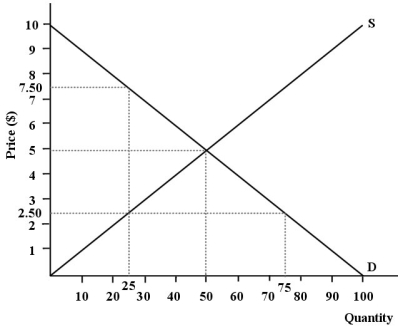 FIGURE 12-4
-At the level of the industry, the condition for productive efficiency is that
FIGURE 12-4
-At the level of the industry, the condition for productive efficiency is that
A) MC = P for all goods.
B) there are no idle resources in the industry.
C) goods are allocated equitably.
D) MC is equal for all firms in the industry.
E) MRP = P for all inputs.
Correct Answer

verified
Correct Answer
verified
Multiple Choice
All points on a country's production possibilities boundary are
A) productively efficient.
B) Pareto optimal.
C) not productively efficient.
D) points at which P = MC for all goods.
E) allocatively efficient.
Correct Answer

verified
Correct Answer
verified
Multiple Choice
If a regulatory agency ordered a public utility (a natural monopoly) to price all of its output at marginal cost, then the firm
A) would incur losses since the demand curve is perfectly elastic.
B) could incur profits or losses depending on the position of the demand curve and the ATC curve.
C) would lose money unless it is subsidized.
D) would have to shut down.
E) would earn profits since the demand curve is perfectly inelastic.
Correct Answer

verified
Correct Answer
verified
Multiple Choice
Consider a regulated natural monopoly, such as an electricity distribution company, that faces falling long-run average costs. If it is forced to price its output at average cost it will provide
A) less output than what is socially optimal.
B) so little output that there will be a shortage.
C) the socially optimal amount of output.
D) more output than what is socially optimal.
E) more output than can be absorbed by the market.
Correct Answer

verified
Correct Answer
verified
Multiple Choice
The diagram below shows cost and revenue curves for a natural monopoly producing electricity. Price is dollars per kilowatt hour and quantity is kilowatt hours per day. 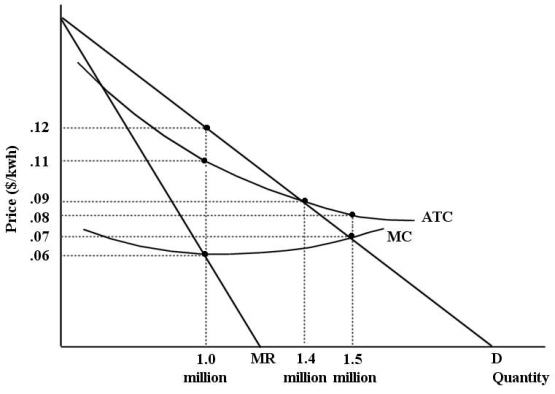 FIGURE 12-7
-Refer to Figure 12-7. Suppose this firm is being regulated using a pricing policy of average-cost pricing. In this case, economic profits are equal to
FIGURE 12-7
-Refer to Figure 12-7. Suppose this firm is being regulated using a pricing policy of average-cost pricing. In this case, economic profits are equal to
A) $0.
B) $10 000.
C) $6000.
D) $126 000.
E) $28 000.
Correct Answer

verified
Correct Answer
verified
Multiple Choice
If a perfectly competitive industry was suddenly monopolized without any change in cost conditions,
A) price would increase and quantity produced would decrease.
B) price would decrease and quantity produced would increase.
C) there would be no change in either price or quantity produced.
D) both price and quantity produced would decrease.
E) both price and quantity produced would increase.
Correct Answer

verified
Correct Answer
verified
Multiple Choice
The diagram below shows supply, demand, and quantity exchanged of Monday matinee movie tickets. Assume it is a perfectly
competitive market. 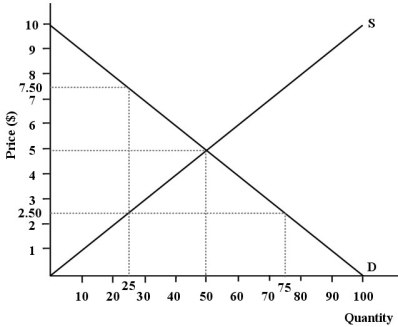 FIGURE 12-4
-The Canadian economy is achieving allocative efficiency if
FIGURE 12-4
-The Canadian economy is achieving allocative efficiency if
A) there are no idle resources in the economy.
B) marginal product is equal for all factors of production.
C) marginal cost is equalized across industries.
D) marginal cost equals price in all industries.
E) price equals average cost in all industries.
Correct Answer

verified
Correct Answer
verified
Multiple Choice
The diagram below shows the market demand curve and the cost curves for a single firm. 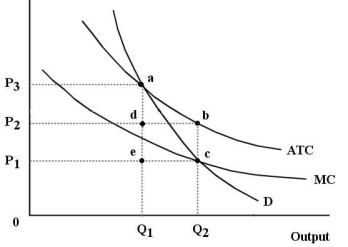 FIGURE 12-6
-Refer to Figure 12-6. Suppose this firm is being regulated using a policy of marginal-cost pricing.To maintain the resulting level of output
FIGURE 12-6
-Refer to Figure 12-6. Suppose this firm is being regulated using a policy of marginal-cost pricing.To maintain the resulting level of output
A) the demand curve would have to shift down.
B) the government would have to accept the allocative inefficiency associated with this level of output.
C) the regulator would have to allow the firm to keep the monopoly profits at this level of output.
D) the government would have to subsidize the firm or it will eventually shut down.
E) the average total cost curve would have to shift up.
Correct Answer

verified
Correct Answer
verified
Multiple Choice
The diagram below shows the market demand curve and the cost curves for a single firm. 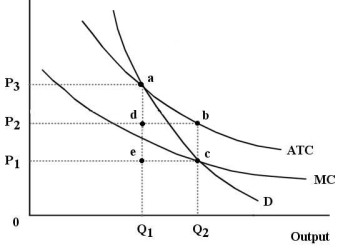 FIGURE 12-6
-Refer to Figure 12-6. Suppose this firm is being regulated using a policy of marginal-cost pricing.In this case,
FIGURE 12-6
-Refer to Figure 12-6. Suppose this firm is being regulated using a policy of marginal-cost pricing.In this case,
A) allocative efficiency is achieved because price equals marginal cost.
B) allocative efficiency is achieved because profits are maximized.
C) the result is allocatively inefficient because the firm is suffering losses.
D) the result is allocatively inefficient because the marginal cost curve lies below the ATC curve.
E) the result is allocatively inefficient because the firm is earning profits.
Correct Answer

verified
Correct Answer
verified
Multiple Choice
For an entire economy, allocative efficiency requires that
A) MRP is equated for all factors of production.
B) goods are allocated equitably across markets.
C) MC = P for all goods.
D) price is greater than marginal cost for all goods.
E) price equals average cost for all goods.
Correct Answer

verified
Correct Answer
verified
Multiple Choice
The diagram below shows the market demand curve and the cost curves for a single firm. 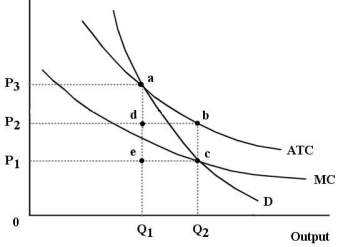 FIGURE 12-6
-Refer to Figure 12-3. Comparing the monopoly equilibrium to the perfectly competitive equilibrium, the area P2P3CB represents
FIGURE 12-6
-Refer to Figure 12-3. Comparing the monopoly equilibrium to the perfectly competitive equilibrium, the area P2P3CB represents
A) the net loss in the monopolist's profits.
B) the dead-weight loss of monopoly.
C) the net gain in the monopolist's profits.
D) a redistribution of income from the monopolist to the consumer.
E) a redistribution of income from consumers to the monopolist.
Correct Answer

verified
Correct Answer
verified
Multiple Choice
The diagram below shows the market demand curve and the cost curves for a single firm.  FIGURE 12-6
-Refer to Figure 12-3. If the diagram depicts a perfectly competitive industry, the equilibrium price and quantity is
FIGURE 12-6
-Refer to Figure 12-3. If the diagram depicts a perfectly competitive industry, the equilibrium price and quantity is
A) P3 and Q₁.
B) P1 and Q₁.
C) P1 and Q₂.
D) P2 and Q₁.
E) P2 and Q₂.
Correct Answer

verified
Correct Answer
verified
Multiple Choice
The diagram below shows supply, demand, and quantity exchanged of Monday matinee movie tickets. Assume it is a perfectly competitive market.  FIGURE 12-4
-Productive efficiency for an individual firm requires that
FIGURE 12-4
-Productive efficiency for an individual firm requires that
A) all resources be fully used.
B) P = ATC for all goods.
C) the firm be allocatively efficient.
D) MC = P for all goods.
E) the firm be on its LRAC curve.
Correct Answer

verified
Correct Answer
verified
Multiple Choice
Choose the statement that best compares the long-run equilibrium of a competitive industry and that in a monopolized industry.
A) It is not possible to make this comparison because firms in a competitive industry operate only in the short run.
B) Allocative efficiency will be achieved in the monopolized, but not the competitive industry.
C) Allocative efficiency is not possible in either industry.
D) Allocative efficiency will be achieved in the competitive, but not the monopolized industry.
E) Resources will be allocated efficiently in both the competitive and monopolized industries.
Correct Answer

verified
Correct Answer
verified
Multiple Choice
In the absence of market failures, allocative efficiency is achieved in a perfectly competitiveindustry because
A) firms do not need to maximize profits.
B) the industry produces a level of output such that there are increasing returns to scale.
C) the industry produces a level of output such that the marginal cost to producers equals the marginal benefit to consumers.
D) there are barriers to entry.
E) the industry produces a level of output such that the marginal cost of production is minimized.
Correct Answer

verified
Correct Answer
verified
Showing 21 - 40 of 96
Related Exams